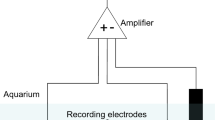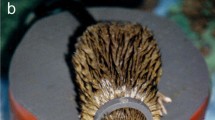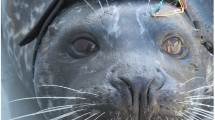Summary
The fresh water sponge Ephydatia fluviatilis contracts rhythmically. At 15° or 16° C the frequency of contraction varies between 4–6 h; the contraction itself takes about 1 or 2 h. Increasing water temperature from 15° to 19° C causes irregular additional contractions, which cease if the temperature is reduced to the initial level (15° C). The results are based upon a non-invasive technique using infrared reflexion.
Zusammenfassung
Der Süßwasserschwamm Ephydatia fluviatilis führt rhythmische Kontraktionen durch. Die Kontraktionsfrequenz beträgt bei 15° bis 16° C vier bis sechs Stunden, der eigentliche Kontraktionsvorgang ein bis zwei Stunden. Die Erhöhung der Wassertemperatur von 15° auf 19° C bewirkt irreguläre, zusätzliche Schwammkontraktionen, die nach Senkung der Temperatur auf die ursprüngliche Höhe (15° C) wieder entfallen. Dieser Aussage liegt die objektschonende Infrarot-Reflexionsmessung zugrunde.
Similar content being viewed by others
Literatur
Bagby RM (1966) The fine structure of Myocytes in the sponges Microciona prolifera (Ellis and Solander) and Tedania ignis (Duchassaing and Michelotti). J Morphol 118:167–182
De Vos L, Van de Vyver G (1981) Étude de la contraction spontanée chez l'éponge d'eau douce Ephydatia fluviatilis cultivée in vitro. Ann Soc R Zool Belg 111:21–31
Fishelson L (1981) Observations on the Moving Colonies of the genus Tethya (Demospongia, Porifera). Zoomorphology 98:89–99
Kilian EF (1952) Wasserströmung und Nahrungsaufnahme beim Süßwaserschwamm Ephydatia fluviatilis. Z Vergl Physiol 34:407–447
Kilian EF, Wintermann-Kilian G (1979) Mouvement cellulaire et contraction chez Spongilla lacustris et Ephydatia fluviatilis. In: Biologie des Spongiaires, Levi C, Boury-Esnault N (eds). Édition du CNRS, Paris 291:137–143
Ledger PW (1975) Septate junctions in the Calcareous sponge Sycon ciliatum. Tissue & Cell 7:13–18
Lethias C, Garrone R, Mazzorana M (1983) Fine structure of sponge cell membranes: Comparative study with freeze-fracture and conventional thin section methods. Tissue & Cell 15:523–535
Mackie GO, Lawn ID, Pavans de Ceccatty M (1983) Studies on Hexactinellid sponges. II. Excitability, conduction and coordination of responses in Rhabdocalyptus dawsoni (Lambe, 1873) Philos Trans R Soc London Ser B 301:401–418
Mackie GO, Singla CL (1983) Studies on Hexactinellid sponges. I. Histology of Rhabdocalyptus dawsoni (Lambe, 1873). Philos Trans R Soc London Ser B 301:365–400
Pavans de Ceccatty M (1966) Connexions cellulaires et jonctions polarisées du réseau intramésenchymateux, chez l'Éponge Hippospongia communis LMK. C R Acad Sci (Paris) D 263:145–147
Pavans de Ceccatty M (1971) Effects of Drugs and Ions on a Primitive System of Spontaneous Contractions in a Sponge (Euspongia officinalis). Experientia 27:57–59
Pavans de Ceccatty M (1974a) Coordination in Sponges. The Foundations of Integration. Am Zool 14:895–903
Pavans de Ceccatty M (1974b) The origin of the integrative systems: A change in view derived from research on coelenterates and sponges. Perspect Biol Med 17:379–390
Pavans de Ceccatty M (1981) Demonstration of actin filaments in sponge cells. Cell Biol Intern Rep 5:945–952
Pavans de Ceccatty M, Thiney Y, Garrone R (1970) Les bases ultrastructurales des communications intercellulaires dans les oscules de quelques éponges. Symp Zool Soc London 25:449–466
Rasmont R (1963) Le rôle de la taille et de la nutrition dans le déterminisme de la gemmulation chez les Spongillides. Dev Biol 8:243–271
Samans KE, Götz von Olenhusen K, Wohlfarth-Bottermann KE (1978) Oscillating contractions in protoplasmic strands of physarum: Infrared reflexion as a non-invasive registration technique. Cell Biol Intern Rep 2:271–278
Weissenfels N (1980) Bau und Funktion des Süßwasserschwamms Ephydatia fluviatilis L. (Porifera). VII. Die Porocyten. Zoomorphologie 95:27–40
Weissenfels N (1982) Bau und Funktion des Süßwasserschwamms Ephydatia fluviatilis L. (Porifera). IX. Rasterelektronenmikroskopische Histologie und Cytologie. Zoomorphology 100:75–87
Weissenfels N (1983) Bau und Funktion des Süßwasserschwamms Ephydatia fluviatilis (Porifera). X. Der Nachweis des offenen Mesenchyms durch Verfütterung von Bäckerhefe (Saccharomyces cerevisiae). Zoomorphology 103:15–23
Wierzejski A (1935) Süßwasserspongien. Monographische Bearbeitung. Mém Acad Polon (B) 9:1–242
Author information
Authors and Affiliations
Rights and permissions
About this article
Cite this article
Weissenfels, N. Bau und Funktion des Süßwasserschwamms Ephydatia fluviatilis (Porifera). Zoomorphology 104, 292–297 (1984). https://doi.org/10.1007/BF00312010
Received:
Issue Date:
DOI: https://doi.org/10.1007/BF00312010




